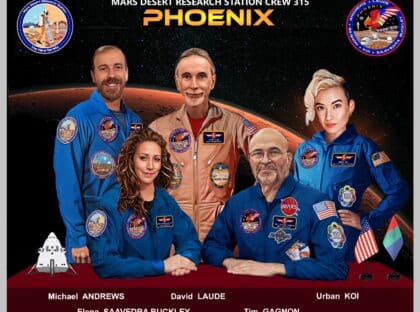
The Mars Society announced today that it is launching an initiative to create the Mars Technology Institute (MTI), whose purpose will be to develop the technologies needed to settle the Red Planet.
Commenting on the project, Mars Society President Dr. Robert Zubrin said: “SpaceX and other entrepreneurial launch companies are already moving rapidly to develop the transportation systems that can get us to the planet Mars. What is needed is an institution devoted to developing the technologies that will allow us to live once we are there.
“All the necessary materials to support human settlement are already on Mars, but we need to create the necessary technologies to transform them into fuel, oxygen, food, bricks, cement, metals, glass, fabrics, plastics, energy, and labor power itself. As I have argued in several publications, Mars cities themselves will be inventors’ colonies devoted to pursuing advances in these areas and will use the resulting technologies both to survive and prosper on the Red Planet and to obtain the income necessary to pay for imports by licensing such inventions on the home planet.

“So why not start such a Mars Technology Institute on Earth now? The business case for investing in such an organization is not as obvious as that for a new launch company or any other firm devoted to addressing an existing terrestrial market. That’s why it hasn’t happened already. The initial funders will have to be motivated by a long-term vision, rather than short-term gain. It is hope, rather than greed, that will get us to Mars.
“But MIT has made a fortune by patenting and licensing the inventions of its scientists. Eventually the MTI will be able to do the same, and in the process of making a bundle not only create the first generation of technologies that will allow us to get started on Mars, but also to demonstrate the practicality of one of the main economic foundations for Mars city states as well.”
In broad terms, the three critical needs that a Mars colony will face are its severe constraints of labor, agricultural land, and sources of energy. To deal with its labor shortage, Mars will need to innovate in the areas of automation, robotics, and artificial intelligence. To deal with its land shortage, Mars will need to innovate in biotech, including genetic engineering, microbial food production, advanced agricultural systems like aquaponics, and synthetic biology. To deal with the fact that it has no fossil fuel or hydro power options and the weakness of solar and wind power sources, Mars will need to innovate in advanced nuclear technologies, including fission and fusion.
For its initial efforts, the MTI will focus on the biotech area. The reason for this choice is that AI is being heavily worked on by others, and advanced nuclear research requires larger capital commitments than we are likely to be able to muster in the short term. In contrast, biotech research projects can be launched with small capital requirements and produce large financial returns to support expanded research. Biotech is also being heavily worked, but current research is not driven by the same constraints and optimization directions as would be faced on the Red Planet, specifically the need to produce food at scale with extreme limitations of arable land.
As Dr. Zubrin explained; “Iowa cornfields are among the most productive farms on Earth, producing 12 metric tons of corn per hectare per year. That’s enough for a hectare to supply 30 people with a kilogram of corn per day, or feed 20 people assuming some land is devoted to fruits, vegetables, and meat. That’s extremely impressive, yet at that rate a 100,000 person Mars town would require 5,000 hectares (50 square kilometers) of farmland – and that’s under the optimistic assumption that such productivity could be achieved at Mars’ half-Iowa solar illumination levels. If we tried to augment production by supplying artificial light at 200 W per square meter (1/5th of Iowa sunlight at noon), we would need 10 Gigawatts of electricity, about a third of the total power consumption of Australia!
“This results from the inefficiency of photosynthesis, which while about 4% at the cellular level, is only about 0.2% efficient in converting the solar energy impacting a cornfield into biologically useful energy in the form of corn. This is not a major problem on Earth, where vast amounts of agricultural land are readily available. But it’s a show stopper for Mars. We need to solve this using biotechnology.
“By so doing, we will not only make it possible for humanity to become multiplanetary, we will decisively refute the canard that space advocates do not care about the basis needs of people on Earth.”
The structure of the MTI will be a non-profit, and it will seek funding based on tax deductible donations. We will also set up a C-Corp, the Mars Technology Lab (MTL), which will be initially 100% owned by the MTI. This will allow MTI to obtain additional support from qualified investors who are committed to the cause of Mars settlement and who understand the long-term nature of the opportunity. MTL will seek opportunities to license or spin off technologies developed by the MTI to create new companies. Dividends from such activities will be paid to MTI and its investors pro-rata.
There will thus be six sources of cash for MTI/MTL: donations, investments, IP licensing income, dividends from spin-off companies, and government and private corporation R&D contracts.
The MTI will conduct research out of its own central campus, but outsource some research work to other companies and universities as deemed most advantageous. MTI will also seek to greatly amplify the amount of research it can do with available funds by not only fully funding professional researchers at its own central facility and some distributed locations, but by providing limited funds for materials to volunteers who propose credible distributed research projects and are willing to do the work without salary.
This continues the tradition the Mars Society has established with its analog research stations and rover competitions, whose productivity per unit cash spent has exceeded commercial standards by several orders of magnitude.

Such volunteer projects, in some cases supervised by teachers making use of their school’s lab facilities, could have great educational value for the student volunteer researcher recruits.
The MTI could thus serve as the flagship of a broadly based international STEM program.
A group of twelve leading experts in the fields of biotechnology, artificial intelligence, and advanced nuclear energy technology has been recruited to form the MTI advisory board.
The location of the MTI central campus has yet to be determined. Leading candidates currently under consideration include the Pacific Northwest and Colorado.
“The MTI could become not only the engine of invention, but also the engine of finance to enable the human exploration and settlement of Mars,” said Dr. Zubrin.
“To quote Frederick Douglas, ‘Who would be free, themselves must strike the blow.’ Rather than rely on NASA to establish humanity on the planet Mars, I suggest we take up the challenge ourselves.
“On to Mars.”
You can donate to assist with the formation of the Mars Technology Institute by going to our main Donate form and selecting “Mars Technology Institute” as the optional “Project or Area for Donation”. For further information about the Mars Society and its mission, please visit our website at: www.marssociety.org.


